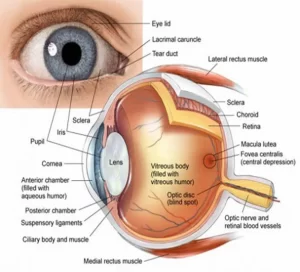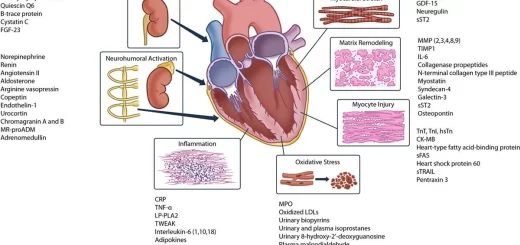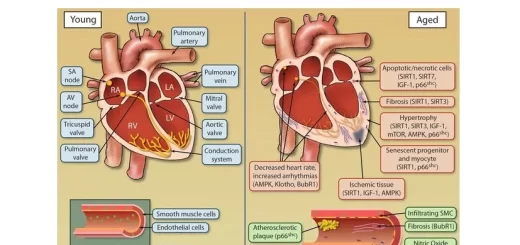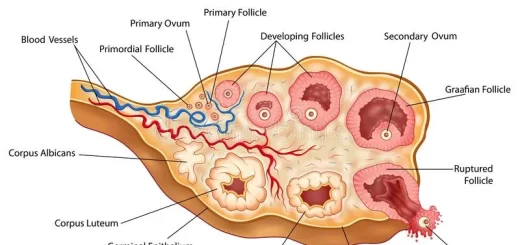Retina function, anatomy, layers and accessory structures of the eye
The retina lines the back of the eye on the inside, It is located near the optic nerve, It receives the light that the lens has focused, converts the light into neural signals, and sends these signals on to the brain for visual recognition, The retina processes the light through a layer of photoreceptor cells, These are light-sensitive cells, responsible for detecting qualities such as color & light-intensity, The retina processes the information gathered by the photoreceptor cells and sends this information to the brain via the optic nerve.
Retina
The retina: this is the inner coat of the eyeball. It consists of two basic layers:
- Pigmented epithelium: an outer non-photosensitive layer. This layer is resting on and firmly attached to the choroid.
- Retina proper: an inner photosensitive part.
Histologically, the retina is formed of 10 parallel layers, which are from outside inward:
1. Retinal pigmented epithelium (RPE)
It consists of a single layer of cuboidal cells. The cell base has numerous invaginations and the cell apex, which faces the rods and cones, shows multiple microvilli that surround the tips of the photoreceptors.
Functions of the RPE & its relation to the histological structure:
- Absorption of light: as indicated by the presence of numerous melanin granules stored in the apical cytoplasm. Melanin absorbs light after the stimulation of photoreceptors.
- Isolation of the neural retinal cells from the blood-borne toxic substances: by tight junctions between the adjacent retinal pigmented epithelial cells. The RPE together with the structure of retinal continuous capillaries forms the blood-retinal barrier.
- Restoration of photosensitivity to visual pigments through vitamin A esterification by the abundant smooth endoplasmic reticulum.
- Renewal of the photoreceptors by phagocytosis of the tips of their outer segments, as indicated by the numerous lysosomes in the apical cytoplasm.
2. Layer of rods & cones (The photoreceptors)
This layer contains the outer and inner segments of the photoreceptor cells; rod and con cells. There are about 120 million receptor cells in each retina; the ratio of rods to cones is 20:1. Rods and cones elongated modified neurons oriented parallel to one another but perpendicular to the retina.
Rods have thin, cylindrical outer segments while cones have short, conical outer segments with their tips invaginated by the microvilli of RPE cells. The outer segments of the rod and cones are formed of numerous, flat membranous discs that contain the light-sensitive ”rhodopsin” which initiates the visual impulses.
3. Outer limiting membrane
It is not a true membrane. It is formed by the junctional complexes between the photoreceptor cells and the supporting Müller’s cells.
4. Outer nuclear layer
It contains the cell bodies of rod and cone cells. Nuclei of rods are small, dark, and found at different levels while the cone nuclei are large, pale, and found at one level near the outer limiting membrane.
5. Outer plexiform layer
It contains the synapses between the synaptic processes of rod and cone cells and the dendrites of the bipolar and Horizontal cells.
6. Inner nuclear layer
It contains the cell bodies of the following cells:
- Bipolar nerve cells: these cells extend from the outer to the inner plexiform layers. The dendrites of these cells establish contact with the rods and cones in the outer plexiform layer. Their axons make up synaptic connections with the ganglion and amacrine cells in the inner plexiform layer.
- Horizontal cells: they are situated close to rods and cones. They establish synaptic contact with rods. cones and bipolar cells.
- Amacrine cells: they are situated close to the ganglion cells. They establish synaptic contact with the dendrites of the ganglion cells and the axons of the bipolar cells.
- Müller’s cells: they are neuroglial cells that extend from the outer to the inner limiting membranes. They have supportive and nutritive functions. They also insulate different cells and fibers of the retina from each other.
7. Inner plexiform layer
This layer is formed by the synaptic neuronal connections between the bipolar and amacrine cells axons with the dendrites of ganglion cells.
8. Ganglion cell layer
This layer contains cell bodies of retinal ganglion cells. They form a single layer of few large pyriform neurons. Their axons converge to form the optic nerve fibers. The retinal blood capillaries are present between the ganglion nerve cells.
9. Layer of optic nerve fibers
In this layer, the axons of the ganglion cells pass at right angles to form the optic nerve. They pierce the sclera at the lamina cribrosa. Optic nerve fibers are myelinated by oligodendrocytes (without neurilemma).
10. Inner limiting membrane
It limits the retina from the inside, separating it from the vitreous. It is made up of the basal lamina of the Müller’s cells.
The accessory structures of the eye
A. Conjunctiva
It is a thin transparent mucous membrane. It covers the anterior surface of the sclera till the cornea (bulbar conjunctiva), then it is reflected at the conjunctival fornix to cover the internal surfaces of the eyelids (palpebral conjunctiva). The conjunctiva consists of stratified columnar epithelium with numerous goblet cells. supported by loose vascular lamina propria.
Conjunctival epithelium changes into non-keratinized stratified squamous at the junction with the cornea and near the margins of the eyelids. The function of the conjunctiva is to lubricate and defend the eye against infection.
B. Eyelids
They are two movable folds of tissues that protect the eye. Eyelashes project from the lid margin. Histologically, the eyelid is formed of the following layers:
1. Skin surface: with fine hairs.
2. Muscles of the eyelid: two striated muscles:
- The Orbicularis oculi muscle, it serves to close the eyelid.
- Levator palpebrae superioris, it serves to elevate the upper eyelid.
Smooth muscle fibers of the superior tarsal muscle (Muller’s muscle), it is inserted in the superior border of the tarsal plate and is supplied by sympathetic nerves.
3. Tarsal plate: It is a curved plate of dense fibro-elastic tissue containing the Meibomian (tarsal) glands. Meibomian glands.
Meibomian glands: these are modified long sebaceous glands embedded in the tarsal plate. They open on the free edge of the eyelid. Their oily secretion prevents rapid evaporation of the tears.
4. The palpebral conjunctiva.
C. The lacrimal apparatus:
It is formed of the lacrimal glands (serous acini secreting tears that moisten and protect the corneal surface). It is located in the anterior superior portion of the orbit. The secretion is continuously drained into the lacrimal canaliculi, lacrimal sac, and finally into the nose through the nasolacrimal duct.
Eyes structure, Histological organization of the fibrous and vascular coast of the eye
Visual system, Bony orbit anatomy, contents & Nerves, Muscles & movements of Eyeball
Sense of vision, Refractive media of the eye, Corneal reflex & Pupillary pathways
Nystagmus types, causes, symptoms Development of CNS & Abnormalities of Spinal cord
You can subscribe to Science Online on YouTube from this link: Science Online




